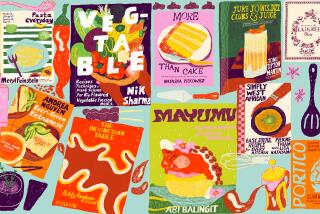Cooks, don’t buy the book -- just wait for the packaging
- Share via
Cookbooks such as “The Complete Idiot’s Guide to 20 Minute Meals” and “Desperation Dinners!” cater to those of us who say we don’t have a lot of time to cook. A new study of L.A. families suggests what we really don’t have time for is -- cookbooks. In a recent study of regular family dining habits, hardly anybody consulted them. And those convenience foods that come pre-washed, pre-diced and pre-sliced? Turns out they don’t save any time on meal preparation at all.
So finds Margaret Beck, an archeologist at the UCLA Center on Everyday Lives of Families, who recently studied the weeknight dinners of 32 median-income Los Angeles families. (The families, which did not know what part of their lives were being studied, were videotaped for a week, from the time family members left work and school until the time the children went to bed. It’s reality TV in the cause of science!)
Beck watched two evening mealtimes from each family’s video, recording who prepared the meals, how many dishes they included, how many prepackaged foods -- such as hot dogs, bottled pasta sauce or flavored rice mixes -- were used, and how long the whole process took.
She found that only 45 of the 64 family dinners -- or 70% -- were home-cooked, compared with 10 purchased as takeout, and three eaten in a restaurant.
Of those 45, only three involved looking at a cookbook, and none used recipes taken from another source, such as a newspaper or magazine.
The instructions consulted most often were those on the back of food packages themselves. Beck also found that meals prepared with “commercial foods” did not take significantly less time to prepare than meals prepared from scratch the way Granny used to make them. In fact, the average meal took 52 minutes to prepare -- even though the use of commercial foods cut “hands-on” time used to chop, wash, or mix ingredients. These semi-prepared foods seemed, instead, to allow for more complex meals, with extra dishes -- often prepared to accommodate the tastes of a particular family member.
Beck points out that ready-to-eat foods -- even if they don’t save time in the kitchen -- might still save time when it comes to shopping or learning to cook.
Mixes might save trips down the spice or produce aisles at the store, she suggests. And those three-step instructions on the back of a box almost never fail, even if you have no clue how to fold in your egg whites or clarify your butter.
The study appears in the July 13 issue of the British Food Journal.
• How to shop more wisely for groceries:
money.cnn.com/magazines/moneymag/moneymag_archive/2006/01/01/8365227/index.htm
• Stories about American eating habits from the 1930’s:
www.npr.org/templates/story/story.php?storyId=4176589
• History of the microwave:www.gallawa.com/microtech/history.html
-- Chelsea Martinez
More to Read
Eat your way across L.A.
Get our weekly Tasting Notes newsletter for reviews, news and more.
You may occasionally receive promotional content from the Los Angeles Times.










